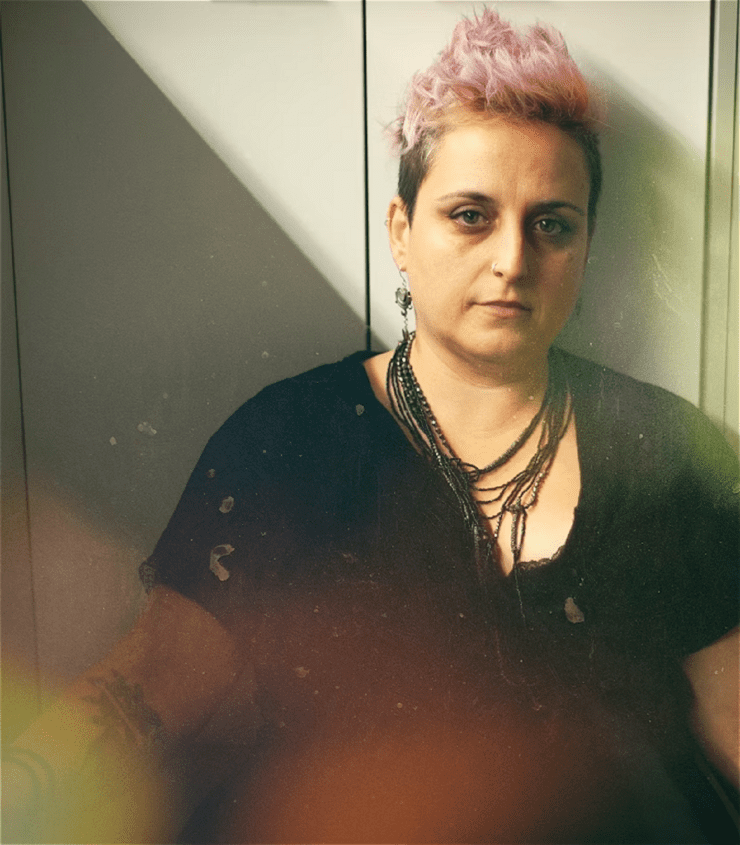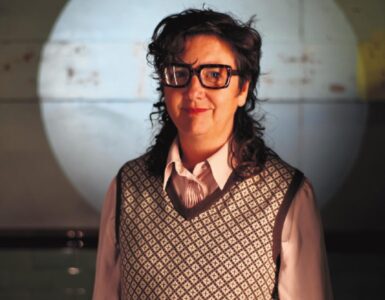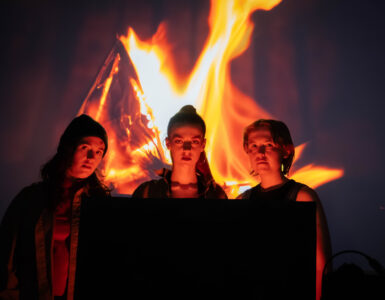The way each individual deals with death, in itself, is a profound human experience. Amanda Santuccione in Twenty Minutes To Nine is a fascinating, captivating and undoubtedly warm story teller. When she speaks, you are there, taking you in any direction she wants you, moulding your heart into the emotion she see’s fit. Covering the different forms grief takes, Amanda vulnerably speaks on pivotal moments in her life. Set in possibly the most intimate room – which felt quite apt – armed with a guitar, a loop pedal and an accordion Amanda uses words, emotions, sound, repetition and acting to allow us to see, listen, understand, and feel, and boy did we feel.
Being in the room with Amanda Santuccione, is like being in the room with a friend gifted with poetic visual storytelling and the courage to be vulnerable. We explore her experience with love, with loss and with loss because of love.
It begins so warmly, a memory from her childhood, her dad positioned at the end of her bed, waiting for her mum to get ready, guitar in hand singing the same song he always sung to her. Santuccione, guitar in hand, playing the chords to the song while brightly bringing us into her childhood home, with her siblings, her parents, the guitar and the sounds. Music, coupled with a story can really elicit some emotions, and with an involuntary smile on my face I was right there, next to her dad, waiting for her mum to get ready.
And in we went, learning about her family, her siblings, where she grew up. Her parents idiosyncrasies, her friends, her siblings friends, the morphing of ones ever changing life as they journey onward. Slowly adding important pieces to the puzzle of Santuccione’s life. Story after story that could be seen as just bits, little anecdotes, but truly showed how they all contributed to create the mosaic of who she was and who she is. And then, arguably one of her most pivotal moments – a friends suicide. Her life now split into a before and after.
An emotionally evoking autobiographical. Delving into the intricate web of what it means to be human, woven with threads of Santuccione’s life before she experienced loss through suicide, and after. Split into two halves she takes us on a journey of understanding, learning, feeling and growth. Navigating the complexities of unanswerable questions, but as humans do, she asks them anyway. Yearning for some knowing, some missed detail that would allow her life to make a bit more sense. Santuccione understood grief now. furthermore, she understood that grief took different forms, and she realised that once you have really experienced grief, if you look hard enough, it can show up almost everywhere.
Santuccione not only took advantage of verbal story telling, but she understood the importance of visual story telling. She performed a sequence in which she reenacted her ritual of making both her and her mum tea. While narrating how her mum would hint at wanting tea but never be able to directly ask for what she wanted, a trait that was carried on within her. “Oh Amanda! Are you making tea? Make one for me too please” With an eye roll she proceeded to make tea for the both of them, never having an original intention to even drink tea. Through well rehearsed and detailed physical repetition, we grew to know the routine. And then, came a pause. A realisation. A slight heartbreak. A room filled with silence as quiet as her now home. Her adept and powerful utilisation of reenactment, pauses and silence really punctuated the moment of realisation that her once reluctant routine, shifted into comfort, has now shifted into a sense of grief for the change of life as she knew it.
Sound is a key player within this performance, one way this is executed is by weaving in the use of a loop pedal to create sonic landscapes. Setting the tone, establishing different atmospheres and aiming for more impactful moments. Although I am a lover of sound and a big believer that, used correctly, sound can elevate the emotions of a story. In this particular performance, it felt like it was disruptive more than anything. Yes, the result sounded cool, but the set up, the creation of it all on stage really took me out of it. One second I was listening to a close friend tell me an intimate story, the next second I was taken out of that story and sitting back in that room watching someone set up a loop pedal to fabricate a sound backdrop. It was a minor drawback cutting into the flow of the whole experience. However, the use of the guitar and the accordion landed extremely well, there was a story to go along with it, they were sentimental, they were important, they amplified the experience, they weren’t just used to create a feeling that wasn’t there to begin with. I felt the loop pedal was the only flaw.
While death, in its various forms, is undeniably tragic, there’s an intrinsic uniqueness to the sorrow that suicide carries. Santuccione keenly delves into this distinction, unraveling the intricate reactions of grief that accompany various forms of loss. The haunting questions of how, why, what could I have done better to prevent this, who else do I need to check in, were their signs? In contrast – death resulting from age or disease may be viewed as more palatable, lacking the thorny doubts that suicide often plants. As this emotional journey unfolds, Santuccione sprinkles in a genuine talent of hers, a showcase of her strategic humour, preventing the show from plunging into somber and depressing territory that it could so easily fall down. Her warm and comforting energy creates a kind of individuality that not only guides us through an emotional odyssey but also skilfully diffuses the heavy atmosphere, while still remaining heavy enough that at times, I couldn’t help but let my tears flow.
From tears to sudden and unexpected laughter, Amanda Santuccione takes us on a journey of her life before her experience with suicide to after, reminding us that grief and loss can take different forms. Sometimes they form habits that domino into even more grief and loss. And occasionally, some losses aren’t people at all, sometimes they are the loss of yourself because your response to all this grief, is simply trying to survive. The irony. She gracefully dances around the message that death is death, and loss is loss, and ultimately, we really all need each other, and boy does she dance around it exquisitely. After all, “life’s a party. At some point we all have to leave; some of us just choose when”
Recommended Drink: As much as I want to say the strongest drink in your cupboard to numb the pain, what’s really needed here, is a comforting warm mug of your favourite tea and a cozy blanket wrapped around you to feel everything that deserves to be felt.
Performances of Twenty Minutes To Nine have now concluded at Melbourne Fringe 2023. Keep up with Amanda online for future showings.









